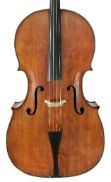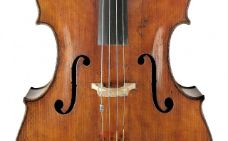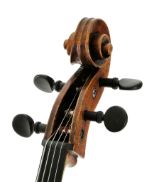Violoncello, Giovanni Battista Guadagnini, Piacenza, 174., “ex von Zweygberg”
Printed label: “Joannes Baptista filius Laurentji Gua- / dagnini fecit Placentiæ 174.” (the last numeral is handwritten and illegible, possibly “3”). Seal with cross and “GBG P.”The literature frequently refers to the father mentioned in the printed label on the cello, Lorenzo Guadagnini (1685–1746), as a violinmaker. However, no records of his work have been found. The cello from the 1740s is one of Guadagnini’s early works. Nevertheless, it possesses many features also found in his later instruments, such as pegbox details or the magnificently carved scroll. Guadagnini’s acquaintances in Piacenza included Carlo Ferrari, an outstanding cello player who is thought to have had a strong influence on Guadagnini. The cello model is relatively short and highly arched; its workmanship and varnish testify to great mastery. The two-piece belly is fine-grained, with the annual rings becoming wider toward the edges. The belly has a knot about 10 cm above the bottom block. A dendrochronological report showed the youngest annual ring to be from 1733, which is consistent with the period shortly after 1740 as the time at which the instrument was made. The divided, slab-cut back exhibits weak horizontal flames, whereas the ribs show intense, wild flames. The pegbox and scroll are made of unflamed maple. The cello has a very full arch that rises straight from the narrow fluting channel. Its back is arched much more than the belly. The upright f-holes are deftly executed, feature very large eyes and are noteworthy for still having very sharp edges. The regular purfling is expertly crafted. The volutes of the highly sculptural scroll show toolmarks as well as layout puncture marks around the eyes. A broad, regular chamfer completes the appearance of the scroll. The varnish layers begin with a yellow ground that is clearly visible, especially on the back. This layer is covered by a luminous red color varnish. The varnish profile is visible above all on the back plate. The instrument is in very good overall condition.
Its first known owner was the Finnish cellist Lennart von Zweygberg (1874–1960). After studying in his home country, he moved to Germany, where he continued his studies, among others with Hugo Becker. Zweygberg was then employed as a solo cello player in orchestras in Helsingfors, Riga and Winterthur. He traveled to many countries in Europe as a soloist between 1910 and 1928, albeit with interruptions caused by World War I. Later, he settled in the USA, where he was appointed professor for cello in Bloomington, Indiana.






